 The story so far The story so far
(First published on
AllAboutSymbian, Feb
2006)
As regular readers may know, Ewan and I, apart from being
fellow AllAboutSymbian scribblers, are equally devoted to
OPL, a system for producing
palmtop and smartphone applications without all that tedious mucking about with
C++ and SDKs. OPL worked well, the applications we produced worked well and all
was rosy for over a decade. But then came Series 60 and some of the vital
tendrils which kept OPL working harmoniously with Symbian OS were
(unintentionally) broken by Nokia. The result was that Series 60 has
effectively been a closed door to OPL and attempts to re-establish contact have
so far come to nothing.
Meanwhile, Nokia themselves had recognised the need for
some kind of Rapid Application Development Language (RAD), a way for people to
produce useful programs without having to spend months learning Java or C++ and
the multi-threading intricacies of Symbian OS. Spying the Open Source Python
language, they presumably preferred it over the equally open OPL because Python
was at heart Internet-focussed and more flexibly structured, better suiting the
needs of a port to a connected smartphone.
Like OPL, Python needs its software system installed on
any device on whicb the Python program is desired to run. Unlike OPL, there's
no need for a translation stage (with a runtime running a 'translated' version
of the program). With Python, the raw text-based code is run ('interpreted')
directly on the device.
In terms of ease of getting started though, both systems
are similar. The Python for Series 60 package includes a number of useful,
working example programs (e.g. a camera interface, an image viewer, a Snake
game, a file manager, etc), which means that only a couple of minutes after
starting, you can be running any of these example Python programs on your
smartphone - and examining the code in your favourite text editor, to see how
they work.
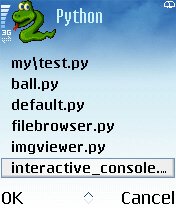  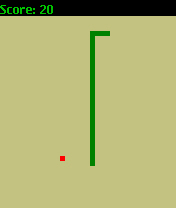
Comparing Python to other systems
The obvious question is "How does Python compare to XXX?",
where XXX is OPL, C++ or Java. Rather cleverly, it has many of the best
attributes of each of these.
Like OPL, it's possible to develop anywhere you can edit a
plain text file, running directly on the smartphone itself. Like OPL, the
functions are high enough in level that you don't have to worry about the
intricacies of threads, buffers and pointers - on the whole, you simply call
the modules and functions needed and leave the rest to the Nokia port of Python
to implement on-the-fly.
Like C++, Python's based around the idea of classes and
objects. Thus, rather than spell every function out in detail, you can set up
an object (like a screen or sound engine or a menu) and then rely to a large
extent on it knowing how to behave when referred to. I'm a complete novice in
'object-oriented programming', so this is one area I'm still very much
learning.
Like Java, Python is very much a cross-platform thing,
although it doesn't pretend to be 'write once, run everywhere'. It's more
'write once, and then tweak it without too much effort for any other platform'.
Python's been ported to Windows, Mac OS, Unix (where it started, of course),
Palm OS, Windows Mobile, and now, of course, Series 60 on Symbian OS. All the
core modules are available on each port, although each platform usually has
extra modules and functions, to take advantage of the unique features of the
platform or of the hardware it's running on (e.g. an
Internet-connected smartphone).
OPL is the most obvious comparison, especially in
view of my experience with it. THE main feature of OPL was that it was possible
to create working programs very quickly without having to go on training
courses and without needing a brain the size of a planet. And hundreds, if not
thousands of home, would-be programmers did just this with OPL, in the mid 90s
on Psion palmtops and later to a lesser degree on the Nokia Series 80
Communicators and on UIQ smartphones.
Can Python be used in the same way? Will it take off and
create a whole user-led enthusiast community in the way Symbian's David Wood
has forecast?
Well, the potential's certainly there. Admittedly Python doesn't ship in any
smartphone's ROM (as OPL did in Psion's heyday), but it's fairly easy to add
and there are vast numbers of Python-programming geeks (like me, hopefully) who
can step in to add the application 'that they need' and then open it up to
others.
What's the catch?
Now, before we get too carried away, Python
isn't going to be the best language in which to implement any
Symbian/Series 60 application. Like OPL, there's just too much overhead in
terms of RAM (typically about 1.5 Megabyte) and in lost processor performance
through having to go through the Python interpreter (though note that if
there's more than one Python program running, they share the interpreter, so
the RAM hit is limited). So we won't be seeing extra Office applications,
graphics suites or route planners. But there are thousands of other niche
applications which have yet to be created for Series 60.
Python's also not the best language for implementing a
commercial (or crippled shareware) application. The plain text of your
application's code is right there for everyone to see. Even when packaging a
Python script in standalone form (see below), your code is all there in
'default.py' in your relevant \system\apps\myapp\ folder. Anyone can copy and
paste this and adapt it and there's little you can do to stop it. (Yes, there's
an obfuscator,
but it's limited by definition in what it can do since at the end of the day
the Python interpreter's still got to run the script.) So Python's best suited
to custom programs, for specific interests, or, of course, for freeware and
fully working shareware (yay!), where there's no real incentive for anyone to
want to try and rip off your work.
It's also worth looking at the code itself, as the focus
and style is very different from OPL. To give an example, to send an SMS from
OPL, you'd have to dig out a specialist OPX (OPl eXtension) and jump through
hoops, if it could be done at all. In Python for Series 60, you simply use
sms_send(recipient, message)
Similarly, to take a photo using the smartphone's camera,
you'd use
take_photo()
When OPL was conceived, this sort of functionality wasn't
dreamed of for the Psion palmtops, so you can't blame OPL for being too
limited. Now, the modules and functions available in Python for S60 v1.3.1
aren't totally complete, and there are various holes, but these should be
filled in quickly now that Python/S60 is Open Source.
Partly redressing the balance, I'd say that Python's
slightly harder to get to grips with for the first time (than OPL), if only
because of the object-orientation used throughout and because of the sheer
scope of its functions. As an Open Source language on other platforms, Python
has acquired an awful lot of libraries and modules...
Overall, though, and especially because of the
non-appearance of OPL for this most successful Symbian OS-based platform, I'd
heartily recommend Python for home, custom or lightly commercial projects.
Taking your first steps
After installing the
Python
interpreter on your S60 smartphone, you'll immediately see a handful of
example scripts and you can run them directly on your device. This will prove
to you that Python's working, at least.
The next step is to create your own program, which is the
exciting bit. Either by modifying one of the examples in your favourite text
editor (I like TextPad), to get a feel
for how real world code looks, or by working through
Jurgen Scheible's little
tutorial series. I can strongly recommend printing off (or keeping open)
the official 'API_Reference_For_Python.pdf' that comes with the Python coding kit.
Initially you can just beam your new script/program (i.e.
the .py file) over to your smartphone, where it will be picked up by the PyS60
recognizer and you simply choose to 'install as script' or 'install as
library'. For most purposes, you'll want to choose 'script'. Then start up the
Python interpreter and run your installed script. Pretty easy!
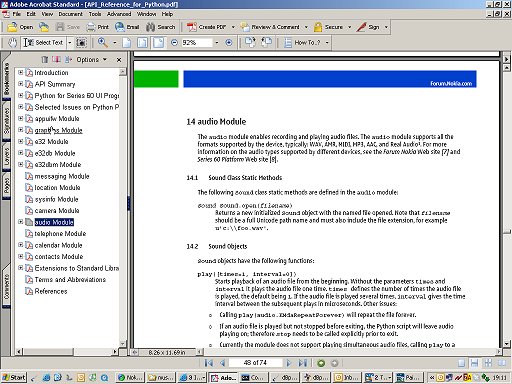
Creating a distributable application
Where things start to get a little more complicated is in
trying to create a Python program that appears to the user as just another S60
application. As part of your Python coding kit, you'll have acquired a little
command line tool called Py2sis. As the name suggests, this takes a Python
script and turns it into a SIS file for installation elsewhere. All the user
needs to do is accept it in the usual way. Oh, and have their own installation
of the Python interpreter, of course.
In the same way as with OPL programs, it's enough to
have a handy download link to the
Python
files page on your own download page, so that users who don't currently
have Python can upgrade their smartphone. Python's a bit of a beast to install
in that it's 500K and takes a minute or so for Symbian OS to physically
process, so you really, really don't want to include the interpreter in the SIS
file along with your tiny, efficient, 10K application.
Getting down and dirty for more ambitious
applications
But what happens when you want to include a proper S60
icon, or include multiple files, such as images and sounds? To achieve
this, you'll need to get your hands dirty slightly. For a start, you'll need
Nokia's full (150MB)
C++ SDK for S60, although you really only need it for some extra
command line tools:
Create yourself a pair of S60 application icons in .BMP
format (44 by 44, 256 colours, plus its 2-bit mask, and 42 by 29, 256 colours,
and its mask). The masks can simply be 2-bit versions (i.e. black and white) of
the icons themselves - professionals will hand craft these to stop rogue pixels
looking 'wrong', but simply saving as black/white is a good first cut at a
mask. Next, combine your four .BMP files using BMCONV. For example, I use a
BMCONV batch file for my example 'musician' application, created for the
purposes of this introduction:
musician.fil contains:
musician.mbm
/8musician44.bmp
musician44mask.bmp
/8musician42.bmp
musician42mask.bmp
Next, you need a UID for your application, a unique
identifier so that your application never gets confused with someone else's.
You can get one from Symbian
here. You'll need
to quote it in making up a special RSS file, such as:
// musician.rss
#include <aiftool.rh>
RESOURCE AIF_DATA
{
caption_list=
{
CAPTION { code=ELangEnglish;
caption="Musician"; },
CAPTION { code=ELangFrench;
caption="Musician";} // to work round an AIFTOOL bug, you need
to have at least
// one language mentioned here
};
// Replace the following app_uid with your program's
UID.
app_uid=0x10000999;
// The number of icons (not including masks)
num_icons=2;
}
Use AIFTOOL to combine your combination .mbm file
with your .RSS file, producing an .AIF (Application Information File)
that's going to tell Symbian OS which icon to display on its menus.
Now the hacking really starts(!) Run Py2Sis, as above, but
with the flag '--leavetemp'. This takes your .py code and constructs an .APP
file, and leaves it, with a .PKG file describing how to make the final SIS
file, all in a ./temp folder for your further use. You now have both
.AIF and .APP and things are looking promising.
Assuming that, like me, you have several ancillary files
that you want packaged in with your Python application, you need to copy them
into the ./temp folder manually. Then edit the PKG file to reference these
extra files (plus the aforementioned AIF one) and make a copy of this in your
root folder so that it won't get forgotten when you zap the ./temp file later
on. I've found it convenient to do these last few steps in a command line
batch file:
py2sis musician.py --leavetemp
copy *.mid
.\temp
! my extra files
copy musician.pkg
.\temp
! my PKG file, corrected for my extra files and the AIF one
copy
musician.aif
.\temp
! my application icon file
copy 3-Lib.cer
.\temp
! optional developer certificate
copy 3-Lib.key
.\temp
! ditto....
cd temp
Finally, run MAKESIS on the PKG file, producing a SIS file
that contains your app, its icon, its files, etc. Job done. Phew!
I should perhaps note at this point that if you get
baffled by any of this (as is likely, at least at first) that you SHOULDN'T
email me directly. The best place to ask Python for Series 60 questions by far
is the official (free)
Forum
Nokia discussion board.
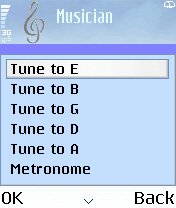 The proof of the pudding The proof of the pudding
So, the code all written and the hard work over, what does
a standalone Python application look like? Well, something I've been after for
ages was a utility to help tune my guitar (and my daughter's violin) and also
display different tempos (i.e. a metronome) - both the existing (C++) S60
applications in this field don't appear to work. So what better test of
Python?
So.... [drum roll] presenting Musician v1.4, all my own
work (apart from all the lines I cribbed from a couple of Jurgen's examples!)
and created in around ten man hours from 'never having seen a line of Python
before' to 'finished and ready for download by the world'. Download it
here.
Interestingly, with my OPL experience, I could have coded
the same thing in one hour flat for UIQ or Series 80, but the learning curve
for Python has definitely been worth climbing, with its potentially more
powerful features and the fact that OPL isn't yet available for S60.
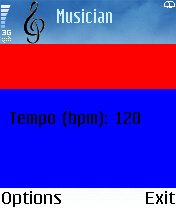 Comments on the application are welcome,
as is comment on how I could improve this introduction to Python. Meanwhile,
I'd urge you to think of an application that you want written and to attempt if
yourself in Python. Start with one of
Jurgen's
templates or examples and build it, step by step, learning Python along the
way. Or, if you're the sort of person who likes doing things strictly by the
book, there are a number of official Python tutorials
online, although there will be modules not available in Python for Series
60 and you won't get quite the same degree of instant gratification of seeing
your ideas come to life on your smartphone. Comments on the application are welcome,
as is comment on how I could improve this introduction to Python. Meanwhile,
I'd urge you to think of an application that you want written and to attempt if
yourself in Python. Start with one of
Jurgen's
templates or examples and build it, step by step, learning Python along the
way. Or, if you're the sort of person who likes doing things strictly by the
book, there are a number of official Python tutorials
online, although there will be modules not available in Python for Series
60 and you won't get quite the same degree of instant gratification of seeing
your ideas come to life on your smartphone.
If you create an application in Python that's worth
sharing, by all means comment here on AllAboutSymbian, drop me an email and
also share it on the Forum Nokia board.
You're not going to become rich through writing Python
programs, the plain text code puts paid to the idea of being too precocious
about your Python ideas, but there's every chance you might get famous as the
creator of something genuinely useful. Get your thinking cap on! |





